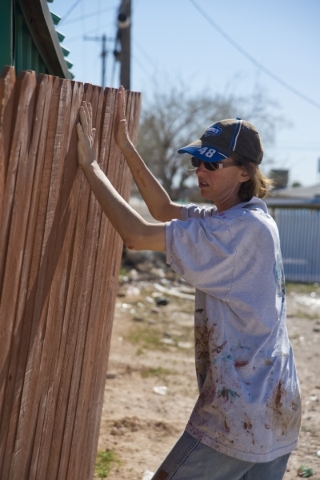Northeast Clark County sees largest increase in residents living under poverty line
Cheaper rents and a shortage of affordable housing elsewhere may explain why northeast Clark County has a higher concentration of poverty than other parts of the county.
East of Interstate 15 near Nellis Air Force Base is one of the few places outside of Las Vegas city boundaries and the Strip where rents are lowest, less than $750 a month in median rent, according to the UNLV Lied Institute for Real Estate Studies apartment survey of the fourth quarter of 2015.
Not surprisingly, it has also experienced the largest increase in residents living below the federal poverty line, according to data provided by the Brookings Institution, which compared 2000 Census tracts to the latest five-year period available, 2010-2014.
Not that the rest of the county has avoided the recession's effects. A closer look at census data shows that poor residents in the city of Las Vegas increased from 11.9 to 17.7 percent. Henderson saw an increase from 5.6 to 10.2 percent in the same period. The rest of the county increased 11.4 percent to 16 percent.
The Brookings research's key finding shows that altogether, poverty in the suburbs of the largest 100 metro areas in the United States were on par with cities for the first time in 2000, then began surpassing them, indicating a tipping point. The Las Vegas Review-Journal, following the same methodology, calculated that the area outside of the two cities is where 52 percent of the poor were already living in 2000, and grew to 57 percent during 2010-2014.
The county's overall population has grown nearly 46 percent since 2000, and so the numbers of individuals living below the poverty line are dramatic. In the city of Las Vegas, counts of poor residents nearly doubled from 56,053 to 104,385; they nearly tripled in Henderson from 9,774 to 26,876. In the remaining areas of the county, outside of the two cities, the numbers increased 125 percent, from 80,028 to 180,418.
"Where you live affects all sorts of things," Brookings Institution fellow Elizabeth Kneebone said during a lecture last week at UNLV.
For example, longer distances to social services usually found in the urban core, less efficiency of public transit to outlying areas, and living away from job opportunities can be a disadvantage.
It's a "pragmatic" problem, said Bob Morgan, president and CEO of the United Way of Southern Nevada. Being farther out can make it more expensive for community service providers to deliver access, he said.
Although more people are in need, United Way funding across the country is flat and has been falling in Southern Nevada, Morgan said. Broadening the donor pool may help, Morgan said, because there's a direct correlation between how many people are asked to donate and how many do.
Morgan came from the United Way in Buffalo, N.Y., to Southern Nevada last October.
"I think that what we saw in Buffalo, New York, is that first ring suburbs had school districts that were doing a bit better, so families would move to access different housing stock," he said.
However, sometimes people find themselves newly poor because of a catastrophic medical event, although they didn't move. These are people who are dropping below the federal poverty line "in place," he said.
"People have preconceived notions of where and what poverty looks like. It's more pervasive what people think," he said. And what about the poor getting poorer? "The truth is that income ranges are polarizing," he said.
While a household of four earning less than $24,250 annually is considered to be living below the federal poverty line in 2015, Morgan said there are better indicators such as the self-sufficiency standard that factors in a cost-of-living adjustment. The federal poverty line has not kept up with inflation since it was set three decades ago, he said.
• 7 for every 100 households making below 15 percent of the area's median income
— Las Vegas Review-Journal writer Alexander S. Corey contributed to this report. Contact Adelaide Chen at achen@reviewjournal.com or 702-383-0281. Find her on Twitter: @adelaide_chen
































